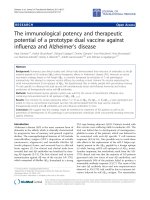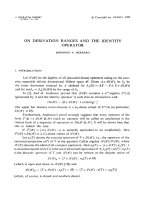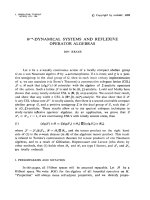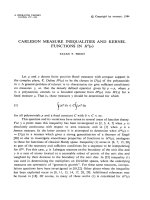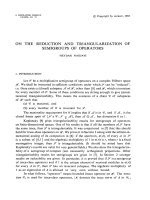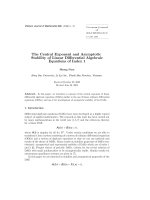Báo cáo toán học: "Adult neurogenesis, neuroinflammation and therapeutic potential of adult neural stem cells" ppsx
Bạn đang xem bản rút gọn của tài liệu. Xem và tải ngay bản đầy đủ của tài liệu tại đây (375.67 KB, 6 trang )
Int. J. Med. Sci. 2008, 5
127
International Journal of Medical Sciences
ISSN 1449-1907 www.medsci.org 2008 5(3):127-132
© Ivyspring International Publisher. All rights reserved
Review
Adult neurogenesis, neuroinflammation and therapeutic potential of adult
neural stem cells
Philippe Taupin
1, 2
1. Fighting Blindness Vision Research Institute, National Institute for Cellular Biotechnology, Glasnevin. Dublin 9, Ireland.
2. Dublin City University, Dublin 9, Ireland.
Correspondence to: Philippe Taupin, Fighting Blindness Vision Research Institute. National Institute for Cellular Biotechnology. Dublin
City University. Glasnevin. Dublin 9, Ireland. Email:
Received: 2008.04.12; Accepted: 2008.06.04; Published: 2008.06.05
The pathogenesis of neurological diseases and disorders remains mostly unknown. Neuroinflammation has been
proposed as a causative factor for neurological diseases. The confirmation that neurogenesis occurs in the adult
brain and neural stem cells (NSCs) reside in the adult central nervous system (CNS) of mammals has tremendous
implications for our understanding of the physio- and pathology of the nervous system. The generation of
newborn neuronal cells in the adult brain is modulated in neurological diseases and during inflammation. This
suggests that adult neurogenesis is involved in the pathogenesis of neurological diseases and disorders,
particularly during neuroinflammation. In this manuscript, we will review the modulation of adult neurogenesis
in neurological diseases and during neuroinflammation. We will discuss the role and contribution of
neuroinflammation and adult neurogenesis to neurological diseases and disorders, and for the therapeutic
potential of adult NSCs.
Key words: neurogenesis, neuroinflammation, neural stem cells
Introduction
Neuroinflammation is a process in which the
brain responds to infections, diseases and injuries [1,
2]. Neuroinflammation involve two types of immune
cells: lymphocytes, monocytes and macrophages of the
hematopoietic system, and microglial cells of the CNS
[3, 4]. Neuroinflammation disrupts the blood-brain
barrier (BBB), allowing cells from the hematopoietic
system to leave the blood stream and come in contact
to the injury site [5]. The immune cells respond to
injuries by eliminating debris and, synthesizing and
releasing a host of powerful regulatory substances, like
the complements, cytokines, chemokines, glutamate,
interleukins, nitric oxide, reactive oxygen species and
transforming growth factors [6-10]. The substances
have both beneficial and harmful effects on the cellular
environment, creating further damages [11] (fig. 1).
Mature astrocytes are also activated following injury to
the CNS [12, 13]. Astrocytic activation is believed to be
necessary for containing the immune response,
repairing the BBB and attenuating further neuronal
death [5, 14].
Contrary to a long-held dogma, neurogenesis
occurs in the brain and NSCs reside in the CNS of
adult mammals, in various species including human
[15, 16]. NSCs are the self-renewing multipotent cells
that generate the main phenotypes of the nervous
system. Neurogenesis is modulated in the brain of
patients and in animal models of neurological diseases
and disorders, like Alzheimer’s disease (AD), epilepsy
and Huntington’s disease (HD) [17]. This suggests that
the adult brain may be amenable to repair and that
adult neurogenesis may contribute to the functioning,
and phyio- and pathology of the CNS, particularly to
the etiology of neurological diseases and disorders.
Neuroinflammation in neurological diseases
and injuries
Inflammation is a process in which the body's
white blood cells and chemicals protect us, from
infections, foreign substances and injuries. In the CNS,
neuroinflammation occurs following traumatic brain
injuries, spinal cord injuries and cerebral strokes. It
involves immune cells from the hematopoietic and
nervous system [1, 2, 6, 18]. It is now well documented
that neuroinflammation is actively involved in
neurological diseases and disorders, like AD,
amyotrophic lateral sclerosis, depression, epilepsy,
HD, multiple sclerosis and Parkinson’s disease (PD)
[19-22]. Particularly, in AD, there is a correlation
between local inflammation, and presence of amyloid
plaques and neurofibrillary tangles [23].
It is proposed that chronic inflammation is a
causative factor to the pathogenesis of neurological
diseases and disorders [20, 24] (fig. 1). The immune
Int. J. Med. Sci. 2008, 5
128
cells and pro-inflammatory chemicals involved in
neuroinflammation would underlie the mechanisms of
diseases and neurodegeneration. The activation, or
over activation, of immune cells involved in
neuroinflammation and release of pro-inflammatory
substances would result in reduced neuroprotection
and neuronal repair, and increased
neurodegeneration, leading to neurodegenerative
diseases [10, 25, 26]. Depression is a common
antecedent to many neurological diseases, particularly
neurodegenerative diseases like AD and PD [27, 28].
Chronic inflammation during depressive episodes
could predispose depressive patients to
neurodegenerative diseases, later in life [29].
Figure 1. Adult neurogenesis and neuroinflammation.
Neuroinflammation has been proposed as a causative factor for
neurological diseases and disorders. It has both beneficial and
harmful effects on the cellular environment. Neuroinflammation
disrupts the BBB. Adult neurogenesis in modulated in a broad
range of neurological diseases and disorders; it is decreased
during inflammation. Adult neurogenesis may be involved in
regenerative attempts and the plasticity of the nervous system.
Adult-derived neural progenitor and stem cells grafted in the
brain promote neuroprotection, by an immunomodulatory
mechanism. Grafted neural progenitor and stem cells interact
with the host immune system to promote functional recovery, an
interaction that may provide clinical benefit for NSC-based
therapy.
Adult neurogenesis, neural stem cells and
cellular therapy
In the adult mammalian brain, including in
humans, neurogenesis occurs primarily in two regions,
the dentate gyrus (DG) of the hippocampus and
subventricular zone (SVZ) [30, 31]. Neurogenesis
involves a relatively small number of cells, particularly
in the DG, and is modulated by environmental stimuli,
trophic factors/cytokines, drug treatments, and in
various physio- and pathological conditions, like
neurological diseases and disorders [32]. Newborn
neuronal cells, in the adult brain, establish functional
connections, survive for extended period of time, at
least 2 years in human, and reproduce processes
similar to development, to integrate the mature
network [30, 33, 34]. Adult neural progenitor and stem
cells have been isolated and characterized in vitro,
from various species [16], including from human
biopsies and post-mortem tissues [35]. It is
hypothesized that newborn neuronal cells in the adult
brain originate from residual stem cells. The existence
of stem cells in the adult brain suggests that it has the
potential for self-repair and that newborn neuronal
cells may contribute to the functioning, and physio-
and pathology of the CNS [36]. However, adult NSCs
remain elusive cells and to be unequivocally identified
and characterized in vitro and in vivo [37, 38].
Two strategies are being considered for adult
NSC-based therapy in the CNS, the stimulation of
endogenous neural progenitor or stem cells and the
transplantation of adult-derived neural progenitor and
stem cells [39]. Self-renewing multipotent neural
progenitor and stem cells have been isolated and
characterized in vitro, from various regions of the
adult mammalian CNS, including the spinal cord [16].
This suggests that neural progenitor and stem cells
reside throughout the adult CNS, in mammals. The
stimulation of endogenous neural progenitor or stem
cells locally would represent a strategy to promote
regeneration of the diseased and injured nervous
system. Alternatively, new neuronal cells are
generated at sites of degeneration in the diseased brain
and after CNS injuries, like in HD and in experimental
models of cerebral strokes 40, 41]. These cells originate
from the SVZ and migrate partially through the
rostro-migratory stream to the sites of degeneration.
This suggests that strategies to promote regeneration
and repair may focus on stimulating SVZ
neurogenesis. Adult derived-neural progenitor and
stem cells may be transplanted locally [42] or
administered intravenously to promote regeneration
and repair [43]. Systemic injection provides a model of
choice for delivering adult derived-neural progenitor
and stem cells for the treatment of neurological
diseases and injuries, where the degeneration is
widespread, like AD and HD.
Adult neurogenesis in neurological diseases and
disorders
Adult neurogenesis is modulated in the brains of
patients and in animal models of neurological diseases
and disorders, like AD, depression, epilepsy,
Huntington’s and Parkinson’s diseases [17].
Neurogenesis is increased in the hippocampus of
Int. J. Med. Sci. 2008, 5
129
brains of patients with AD, as revealed after autopsies
by an increase in the expression of markers for
immature neuronal cells, like doublecortin and
polysialylated nerve cell adhesion molecule, in
hippocampal regions [44]. In animal models of AD,
neurogenesis is increased in the DG of transgenic mice
expressing the Swedish and Indiana amyloid protein
precursor (APP) mutations, a mutant form of human
APP, [45] and decreased in the DG and SVZ of
knock-out mice for presenilin 1 and APP [46, 47]. This
shows that adult neurogenesis is enhanced in AD
brains. The discrepancies observed on adult
neurogenesis in brain autopsies of patients with AD
and animal models of AD may originate from the
limitations of animal models, particularly transgenic
mice, as representative models of complex diseases,
particularly AD [48] and to study adult phenotypes,
like adult neurogenesis. Result from autopsies reveals
that neurogenesis is not altered in the brains of
depressive patients [49]. Neurogenesis is enhanced in
the DG and SVZ of animal models of epilepsy, like
after pilocarpine treatment [50]. After pilocarpine
treatment, ectopic granule-like cells in the hilus are
labeled for bromodeoxyuridine (BrdU). BrdU is a
thymidine analog that incorporates DNA of dividing
cells during the S-phase of the cell cycle and is used for
birthdating and monitoring cell proliferation [51].
MF-like processes immunostained for TOAD-64, a
marker for newly generated neuronal cells, are also
detected in the granule cell layer of the stratum oriens of
CA3 and the inner molecular layer of the DG, in
rodents [50]. Low-dose, whole-brain, X-ray irradiation
in adult rats, after pilocarpine treatment, inhibits
neurogenesis, but does not prevent seizure-induced
ectopic granule-like cells and MF sprouting [52].
Hence, neurogenesis is enhanced in the DG and SVZ in
animal models of epilepsy and seizure-induced ectopic
granule-like cells and MF sprouting arises not only
from newborn neuronal cells, but also from mature
dentate granule cells. Immunohistochemistry and
confocal microscopy analysis of autopsies for markers
of the cell cycle and neuronal differentiation, like
proliferating cell nuclear antigen and β-tubulin, show
that cell proliferation and neurogenesis are increased
in the SVZ of brains of patients with HD [41]. In adult
R6/1 transgenic mouse model of HD, neurogenesis
decreases in the DG [53]. After quinolinic acid striatal
lesioning of adult brain, neurogenesis is increased in
the SVZ [54], as observed in brains of HD patients [41].
These data provide evidences that adult neurogenesis
is increased in the SVZ of brains with HD. Data from
R6/1 transgenic mouse model of HD are difficult to
interpret in the context of adult neurogenesis in HD, as
mutated forms of huntingtin affect brain development
[55]. This could underlie the decrease of neurogenesis
reported in adult transgenic mice R6/1. In PD, one
study reports that the rate of neurogenesis, measured
by BrdU labeling, is stimulated in the substantia nigra
(SN), following lesion induced by a systemic dose of
MPTP (1-methyl-4-phenyl-1,2,3,6-tetrahydropyridine)
[56]. Another study reports no evidence of new
dopaminergic neurons in the SN of
6-hydroxydopamine-lesioned hemi-Parkinsonian
rodents [57]. Hence, neurogenesis in the SN is the
source of debates and controversies, and remains to be
further evaluated.
In all, adult neurogenesis in modulated in a broad
range of neurological diseases and disorders (fig. 1).
The contribution and significance of this modulation to
the etiology and pathogenesis of neurological diseases
and disorders remain mostly unknown. In epilepsy,
low-dose, whole-brain, X-ray irradiation in adult rats,
after pilocarpine treatment, inhibits neurogenesis, but
does not prevent the induction of recurrent seizures
[52]. These data provide a strong argument against a
critical role of adult neurogenesis in epileptogenesis.
However, although increased hippocampal
neurogenesis may not be critical to epileptogenesis, it
could be a contributing factor to limbic seizures when
present. In depression, chronic administration of
antidepressants, like the selective serotonin reuptake
inhibitors fluoxetine, increases neurogenesis in the DG,
but not the SVZ in adult rats, suggesting that adult
neurogenesis is involved in the activity of
antidepressants [58, 59]. X-irradiation of the
hippocampal region, but not other brain regions, like
the SVZ or the cerebellar region, inhibits neurogenesis
and prevents the behavioral effect of the
antidepressants, like fluoxetine, in adult mice [60].
Hence, it is proposed that adult neurogenesis mediate
the activities of antidepressants, particularly selective
serotonin reuptake inhibitors. In HD, in brains of HD
patients and after quinolinic acid striatal lesioning of
adult brain the enhanced neurogenesis in the SVZ
leads to the migration of neuroblasts and formation of
new neuronal cells in damaged areas of the striatum.
This suggests that neurogenesis may be involved in
regenerative attempts in HD brains [41, 54] (fig. 1).
There are however debates and controversies
over the modulation of adult neurogenesis in
neurological diseases and disorders, particularly for
studies involving BrdU labeling for studying
neurogenesis. BrdU is a thymidine analog that
incorporates DNA of dividing cells during the S-phase
of the cell cycle and is used for birthdating and
monitoring cell proliferation [51]. There are limitations
and pitfalls over the use of BrdU for studying
neurogenesis. BrdU is toxic and mutagenic substances.
Int. J. Med. Sci. 2008, 5
130
It triggers cell death, the formation of teratomes, alters
DNA stability, lengthens the cell cycle, and has
mitogenic, transcriptional and translational effects on
cells that incorporate it. BrdU is not a marker for cell
proliferation, but a marker for DNA synthesis [61-63].
High level, 4 to 10%, of tetraploid nerve cells have been
reported in regions in which degeneration occurs in
AD, like the hippocampus [64]. It is proposed that cell
cycle re-entry and DNA duplication, without cell
proliferation, precede neuronal death in degenerating
regions of the CNS [65]. Some of the data observed by
mean of immunohistochemistry for cell cycle proteins
and BrdU labeling in the brains of AD patients and in
animal models of the disease, may therefore not
represent adult neurogenesis, but rather labeled nerve
cells that may have entered the cell cycle and
underwent DNA replication, but did not complete the
cell cycle [62]. In addition, many physio- and
pathological processes, like exercise, neurological
diseases and injuries, like AD, PD and cerebral strokes
and drugs treatments affect the permeability of the
BBB and cerebral flow [66-68]. Some of the data
observed by mean of BrdU labeling in animal models
of neurological diseases and after drug treatments may
reflect bio-availability of BrdU in the brain, rather than
neurogenesis.
Neuroinflammation in adult neurogenesis
Neuroinflammation inhibits neurogenesis in the
adult hippocampus [69, 70] (fig. 1). The mechanism,
function and significance of the modulation of
neurogenesis during inflammatory processes remain
to be elucidated. Molecules released by the immune
cells, like interleukins and nitric oxide, regulate
negatively adult neurogenesis and may underlie the
molecular mechanisms of inflammatory reactions on
adult neurogenesis [71, 72]. Neuroinflammation is
actively involved in neurological diseases and
disorders, like AD, depression and PD [19-22]. It is
proposed that chronic inflammation is a causative
factor to the pathogenesis of these neurological
diseases and disorders [20, 24]. Hence, the modulation
of adult neurogenesis during the inflammatory process
may contribute or cooperate with the activity of
neurological diseases and disorders on adult
neurogenesis. Since the function of newborn neuronal
cells is still the subject of debates and remains to be
elucidated, the significance of the modulation of adult
neurogenesis during inflammatory processes and in
neurological diseases and disorders can only be
speculated. Newborn neuronal cells may represent a
regenerative attempt and contribute to the plasticity of
the nervous system [73] (fig. 1).
There are however debates and controversies
over the modulation of adult neurogenesis during
inflammatory processes, particularly for studies
involving BrdU labeling for studying neurogenesis.
Neuroinflammation alters the permeability of the BBB
[5]. Hence, some of the data observed by mean of BrdU
labeling in animal models during inflammatory
processes may reflect bio-availability of BrdU in the
brain, rather than neurogenesis. Investigators have
used X-ray irradiation to inhibit neurogenesis and
study the function of adult neurogenesis [52, 60, 74].
Brain irradiation induces inflammatory responses (fig.
1). Hence, the effects of brain irradiation on adult
neurogenesis in animal models, particularly of
neurological diseases and disorders, are therefore
difficult to interpret in light of these data. In all, the
modulation of adult neurogenesis during
inflammatory processes and after X-irradiation
treatments remains to be further evaluated.
Neural progenitor and stem cells express
receptors, and respond to trophic factors and
cytokines. Hence, the inflammation resulting from the
pathological processes to be treated by the
transplantation of neural progenitor and stem cells, as
well as the transplantation procedure itself may have
adverse effects of the success of the graft (fig. 1). The
timing of transplantation in the diseased brain or after
injury is therefore critical for successful transplantation
of neural progenitor and stem cell therapy [75]. Studies
reveal that adult-derived neural progenitor and stem
cells promote neuroprotection, by an
immunomodulatory mechanism [76] (fig. 1). Grafted
neural progenitor and stem cells interact with the host
to promote functional recovery, an interaction that
may provide clinical benefit for NSC-based therapy
(fig. 1). The interaction of grafted neural progenitor
and stem cells with the immune system suggests that
pre-clinical studies involving immuno-depressed mice
may not represent an appropriate model to
characterize and validate sources of human-derived
neural progenitor and stem cells for therapy [77].
Conclusion and Perspectives
Neuroinflammation is involved in the
pathogenesis of neurological diseases and disorders,
but its contribution and involvement to these
pathological processes remain to be elucidated. It may
be involved in the modulation of neurogenesis in
neurological diseases and disorders, but the
contribution and significance of this modulation
remain to be understood. Neuroinflammation has
tremendous implications for cellular therapy. On the
one hand, it may limit the therapeutic potential of
adult NSCs in vivo and ex vivo. On the other hand, it
may interact with the neurogenic niches to promote
the regenerative potential in vivo, and the integration
of the grated neural progenitor and stem cells ex vivo.
Int. J. Med. Sci. 2008, 5
131
Hence, neuroinflammation may have both beneficial
and detrimental effects on the potential of adult NSCs,
to promote regeneration and repair in vivo and ex
vivo. Therapeutic strategies for promoting the
potential of adult NSCs in vivo and ex vivo may
involve pro- and anti-inflammatory treatments. Future
studies will aim at unraveling the molecular
mechanisms governing the interaction between neural
progenitor and stem cells and the immune system, and
it implications for cellular therapy.
Conflict of interest
The author has declared that no conflict of
interest exists.
References
[1] Nencini P, Sarti C, Innocenti R, et al. Acute inflammatory events
and ischemic stroke subtypes. Cerebrovasc Dis. 2003; 15: 215-21.
[2] Schmidt OI, Heyde CE, Ertel W, Stahel PF. Closed head
injury an inflammatory disease? Brain Res. Brain Res Rev. 2005;
48: 388-99.
[3] Stoll G, Jander S. The role of microglia and macrophages in the
pathophysiology of the CNS. Prog Neurobiol. 1999; 58: 233-47.
[4] Streit WJ, Walter SA, Pennell NA. Reactive microgliosis. Prog
Neurobiol. 1999; 57: 563-81.
[5] Lossinsky AS, Shivers RR. Structural pathways for
macromolecular and cellular transport across the blood-brain
barrier during inflammatory conditions. Histol Histopathol.
2004; 19: 535-64.
[6] Ghirnikar RS, Lee YL, Eng LF. Inflammation in traumatic brain
injury: role of cytokines and chemokines. Neurochem Res. 1998;
23: 329-40.
[7] Jander S, Schroeter M, Stoll G. Interleukin-18 expression after
focal ischemia of the rat brain: association with the late-stage
inflammatory response. J Cereb Blood Flow Metab. 2002; 22:
62-70.
[8] Stoll G, Schroeter M, Jander S, et al. Lesion-associated expression
of transforming growth factor-beta-2 in the rat nervous system:
evidence for down-regulating the phagocytic activity of
microglia and macrophages. Brain Pathol. 2004; 14: 51-8.
[9] Hensley K, Mhatre M, Mou S, et al. On the relation of oxidative
stress to neuroinflammation: lessons learned from the
G93A-SOD1 mouse model of amyotrophic lateral sclerosis.
Antioxid Redox Signal. 2006; 8: 2075-87.
[10] Bonifati DM, Kishore U. Role of complement in
neurodegeneration and neuroinflammation. Mol Immunol.
2007; 44: 999-1010.
[11] Stoll G, Jander S, Schroeter M. Detrimental and beneficial effects
of injury-induced inflammation and cytokine expression in the
nervous system. Adv Exp Med Biol. 2002; 513: 87-113.
[12] Latov N, Nilaver G, Zimmerman EA, et al. Fibrillary astrocytes
proliferate in response to brain injury: a study combining
immunoperoxidase technique for glial fibrillary acidic protein
and radioautography of tritiated thymidine. Dev Biol. 1979; 72:
381-4.
[13] Miyake T, Hattori T, Fukuda M, et al. Quantitative studies on
proliferative changes of reactive astrocytes in mouse cerebral
cortex. Brain Res. 1988; 451: 133-8.
[14] Bush TG, Puvanachandra N, Horner CH, et al. Leukocyte
infiltration, neuronal degeneration, and neurite outgrowth after
ablation of scar-forming, reactive astrocytes in adult transgenic
mice. Neuron. 1999; 23: 297-308.
[15] Gross CG. Neurogenesis in the adult brain: death of a dogma.
Nat Rev Neurosci. 2000; 1: 67-73.
[16] Taupin P, Gage FH. Adult neurogenesis and neural stem cells of
the central nervous system in mammals. J Neurosci Res. 2002;
69:745-9.
[17] Grote HE, Hannan AJ. Regulators of adult neurogenesis in the
healthy and diseased brain. Clin Exp Pharmacol Physiol. 2007;
34: 533-45.
[18] Stoll G, Jander S, Schroeter M. Inflammation and glial responses
in ischemic brain lesions. Prog Neurobiol. 1998; 56: 149-71.
[19] Minghetti L. Role of inflammation in neurodegenerative
diseases. Curr Opin Neurol. 2005; 18: 315-21.
[20] Eikelenboom P, Veerhuis R, Scheper W, et al. The significance of
neuroinflammation in understanding Alzheimer's disease. J
Neural Transm. 2006; 113: 1685-95.
[21] Hensley K, Mhatre M, Mou S, et al. On the relation of oxidative
stress to neuroinflammation: lessons learned from the
G93A-SOD1 mouse model of amyotrophic lateral sclerosis.
Antioxid Redox Signal. 2006; 8: 2075-87.
[22] Klegeris A, Schulzer M, Harper DG, McGeer PL. Increase in core
body temperature of Alzheimer's disease patients as a possible
indicator of chronic neuroinflammation: a meta-analysis.
Gerontology. 2007; 53: 7-11.
[23] Sivaprakasam K. Towards a unifying hypothesis of Alzheimer's
disease: cholinergic system linked to plaques, tangles and
neuroinflammation. Curr Med Chem. 2006; 13: 2179-88.
[24] Whitton PS. Inflammation as a causative factor in the aetiology
of Parkinson's disease. Br J Pharmacol. 2007; 150: 963-76.
[25] Zilka N, Ferencik M, Hulin I. Neuroinflammation in Alzheimer's
disease: protector or promoter? Bratisl Lek Listy. 2006; 107:
374-83.
[26] Donnelly DJ, Popovich PG. Inflammation and its role in
neuroprotection, axonal regeneration and functional recovery
after spinal cord injury. Exp Neurol. 2007; 209: 378-88.
[27] Karceski S. Early Parkinson disease and depression. Neurology.
2007; 69: E2-3.
[28] Potter GG, Steffens DC. Contribution of depression to cognitive
impairment and dementia in older adults. Neurologist. 2007; 13:
105-17.
[29] Leonard BE. Inflammation, Depression and Dementia: Are they
Connected? Neurochem Res. 2007; 32: 1749-56.
[30] Eriksson PS, Perfilieva E, Bjork-Eriksson T, et al. Neurogenesis
in the adult human hippocampus. Nat Med. 1998; 4: 1313-7.
[31] Curtis MA, Kam M, Nannmark U, et al. Human neuroblasts
migrate to the olfactory bulb via a lateral ventricular extension.
Science. 2007; 315: 1243-9.
[32] Taupin P. Adult neurogenesis in the mammalian central
nervous system: functionality and potential clinical interest.
Med
Sci Monit. 2005; 11: RA247-52.
[33] van Praag H, Schinder AF, Christie BR, et al. Functional
neurogenesis in the adult hippocampus. Nature. 2002; 415:
1030-4.
[34] Esposito MS, Piatti VC, Laplagne DA, et al. Neuronal
differentiation in the adult hippocampus recapitulates
embryonic development. J Neurosci. 2005; 25: 10074-86.
[35] Palmer TD, Schwartz PH, Taupin P, et al. Cell culture.
Progenitor cells from human brain after death. Nature. 2001;
411:42-3.
[36] Taupin P. Adult neurogenesis in mammals. Curr Opin Mol
Ther. 2006; 8: 345-51.
[37] Kornblum HI, Geschwind DH. Molecular markers in CNS stem
cell research: hitting a moving target. Nat Rev Neurosci. 2001; 2:
843-6.
[38] Bull ND, Bartlett PF. 2005. The adult mouse hippocampal
progenitor is neurogenic but not a stem cell. J Neurosci. 2005; 25:
10815-21.
[39] Taupin P. The therapeutic potential of adult neural stem cells.
Curr Opin Mol Ther. 2006; 8: 225-31.
[40] Arvidsson A, Collin T, Kirik D, et al. Neuronal replacement
Int. J. Med. Sci. 2008, 5
132
from endogenous precursors in the adult brain after stroke. Nat
Med. 2002; 8: 963-70.
[41] Curtis MA, Penney EB, Pearson AG, et al. Increased cell
proliferation and neurogenesis in the adult human Huntington’s
disease brain. Proc Natl Acad Sci U S A. 2003; 100: 9023-7.
[42] Shihabuddin LS, Horner PJ, Ray J, Gage FH. 2000. Adult spinal
cord stem cells generate neurons after transplantation in the
adult dentate gyrus. J Neurosci. 2000; 20: 8727-35.
[43] Pluchino S, Quattrini A, Brambilla E, et al. Injection of adult
neurospheres induces recovery in a chronic model of multiple
sclerosis. Nature. 2003; 422: 688-94.
[44] Jin K, Peel AL, Mao XO, et al. Increased hippocampal
neurogenesis in Alzheimer’s disease. Proc Natl Acad Sci U S A.
2004; 101: 343-7.
[45] Jin K, Galvan V, Xie L, et al. Enhanced neurogenesis in
Alzheimer’s disease transgenic (PDGF-APPSw,Ind) mice. Proc
Natl Acad Sci U S A. 2004; 101: 13363-7.
[46] Feng R, Rampon C, Tang YP, et al. Deficient neurogenesis in
forebrain-specific presenilin-1 knockout mice is associated with
reduced clearance of hippocampal memory traces. Neuron.
2001; 32, 911-26. Erratum in: Neuron. 2002; 33: 313.
[47] Wen PH, Shao X, Shao Z, et al. Overexpression of wild type but
not an FAD mutant presenilin-1 promotes neurogenesis in the
hippocampus of adult mice. Neurobiol Dis. 2002; 10: 8-19.
[48] Dodart JC, Mathis C, Bales KR, Paul SM. Does my mouse have
Alzheimer’s disease? Genes Brain Behav. 2002; 1: 142-55.
[49] Reif A, Fritzen S, Finger M, et al. Neural stem cell proliferation is
decreased in schizophrenia, but not in depression. Mol
Psychiatry. 2006; 11: 514-22.
[50] Parent JM, Yu TW, Leibowitz RT, et al. Dentate granule cell
neurogenesis is increased by seizures and contributes to
aberrant network reorganization in the adult rat hippocampus. J
Neurosci. 1997; 17: 3727-38.
[51] Miller MW, Nowakowski RS. Use of
bromodeoxyuridine-immunohistochemistry to examine the
proliferation, migration and time of origin of cells in the central
nervous system. Brain Res. 1988; 457: 44-52.
[52] Parent JM, Tada E, Fike JR, Lowenstein DH. Inhibition of
dentate granule cell neurogenesis with brain irradiation does not
prevent seizure-induced mossy fiber synaptic reorganization in
the rat. J Neurosci. 1999; 19: 4508-19.
[53] Lazic SE, Grote H, Armstrong RJ, et al. Decreased hippocampal
cell proliferation in R6/1 Huntington’s mice. Neuroreport. 2004;
15: 811-3.
[54] Tattersfield AS, Croon RJ, Liu YW, et al. Neurogenesis in the
striatum of the quinolinic acid lesion model of Huntington’s
disease. Neurosci. 2004; 127: 319-32.
[55] White JK, Auerbach W, Duyao MP, et al. Huntingtin is required
for neurogenesis and is not impaired by the Huntington’s
disease CAG expansion. Nat Genet. 1997; 17: 404-10.
[56] Zhao M, Momma S, Delfani K, et al. Evidence for neurogenesis
in the adult mammalian substantia nigra. Proc Natl Acad Sci U S
A. 2003; 100:7925-30.
[57] Frielingsdorf H, Schwarz K, Brundin P, Mohapel P. No evidence
for new dopaminergic neurons in the adult mammalian
substantia nigra. Proc Natl Acad Sci U S A. 2004; 101: 10177-82.
[58] Malberg JE, Eisch AJ, Nestler EJ, Duman RS. Chronic
antidepressant treatment increases neurogenesis in adult rat
hippocampus. J Neurosci. 2000; 20: 9104-10.
[59] Malberg JE, Duman RS. Cell proliferation in adult hippocampus
is decreased by inescapable stress: reversal by fluoxetine
treatment. Neuropsychopharmacology. 2003; 28: 1562-71.
[60] Santarelli L, Saxe M, Gross C, et al. Requirement of hippocampal
neurogenesis for the behavioral effects of antidepressants.
Science. 2003; 301: 805-9.
[61] Nowakowski RS, Hayes NL. Stem cells: the promises and
pitfalls. Neuropsychopharmacol. 2001; 25: 799-804.
[62] Taupin P. BrdU Immunohistochemistry for Studying Adult
Neurogenesis: paradigms, pitfalls, limitations, and validation.
Brain Res Rev. 2007; 53: 198-214.
[63] Taupin P. Protocols for Studying Adult Neurogenesis: Insights
and Recent Developments. Regenerative Medicine. 2007; 2:
51-62.
[64] Yang Y, Geldmacher DS, Herrup K. DNA replication precedes
neuronal cell death in Alzheimer’s disease. J Neurosci. 2001; 21:
2661-8.
[65] Herrup K, Neve R, Ackerman SL, Copani A. Divide and die: cell
cycle events as triggers of nerve cell death. J Neurosci. 2004; 24:
9232-9.
[66] Deane R, Zlokovic BV. Role of the blood-brain barrier in the
pathogenesis of Alzheimer's disease. Curr Alzheimer Res. 2007;
4: 191-7.
[67] Desai BS, Monahan AJ, Carvey PM, Hendey B. Blood-brain
barrier pathology in Alzheimer's and Parkinson's disease:
implications for drug therapy. Cell Transplant. 2007; 16:285-99.
[68] Pereira AC, Huddleston DE, Brickman AM, et al. An in vivo
correlate of exercise-induced neurogen
esis in the adult dentate
gyrus. Proc Natl Acad Sci U S A. 2007; 104: 5638-43.
[69] Ekdahl CT, Claasen JH, Bonde S, et al. Inflammation is
detrimental for neurogenesis in adult brain. Proc Natl Acad Sci
U S A. 2003; 100: 13632-7.
[70] Monje ML, Toda H, Palmer TD. Inflammatory blockade restores
adult hippocampal neurogenesis. Science. 2003; 302: 1760-5.
[71] Vallieres L, Campbell IL, Gage FH, Sawchenko PE. Reduced
hippocampal neurogenesis in adult transgenic mice with chronic
astrocytic production of interleukin-6. J Neurosci. 2002; 22:
486-92 .
[72] Packer MA, Stasiv Y, Benraiss A, et al. Nitric oxide negatively
regulates mammalian adult neurogenesis. Proc Natl Acad Sci U
S A. 2003; 100: 9566-71.
[73] Taupin P. Adult neurogenesis and neuroplasticity. Restor
Neurol Neurosci. 2006; 24: 9-15.
[74] Tada E, Parent JM, Lowenstein DH, Fike JR. X-irradiation causes
a prolonged reduction in cell proliferation in the dentate gyrus
of adult rats. Neurosci. 2000; 99: 33-41.
[75] Mueller FJ, McKercher SR, Imitola J, et al. At the interface of the
immune system and the nervous system: how
neuroinflammation modulates the fate of neural progenitors in
vivo. Ernst Schering Res Found Workshop. 2005; 53: 83-114.
[76] Pluchino S, Zanotti L, Rossi B, et al. Neurosphere-derived
multipotent precursors promote neuroprotection by an
immunomodulatory mechanism. Nature. 2005; 436: 266-71.
[77] Taupin P. HuCNS-SC (StemCells). Curr Opin Mol Ther. 2006; 8:
156-63.
